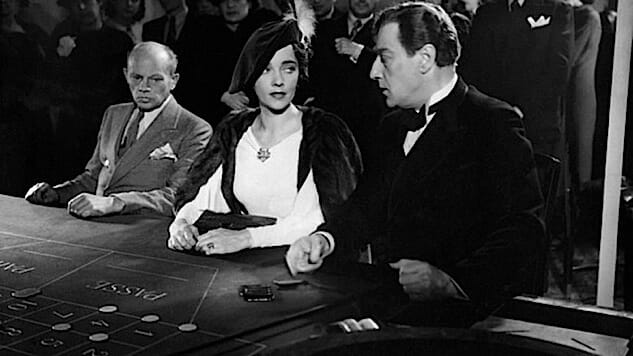Sacha Guitry: The Mostly Forgotten Master

For Sacha Guitry, making movies was never his endgame. Born into a theater family in 1885, Guitry followed in the footsteps of his famous actor father, Lucien, and made a name for himself early in his career as an actor and playwright, penning everything from historical dramas to light comedies. He made one film in 1915, a short documentary named Ceux de chez nous (Those of Our Home) celebrating some of the brightest French creative minds of the day. Otherwise, cinema interested him not one bit … at least until the increasing popularity of sound cinema in the 1930s, when he—an artist of exuberant wit very much devoted to the possibilities of the spoken word—began to reconsider his initial objections and dived more deeply into filmmaking.
What resulted were some of the freshest, funniest and above all most cinematically innovative films of the early sound era, the finest of which turns 80 this year: his 1936 film The Story of a Cheat. And yet, it’s likely that you haven’t heard of either that film or this filmmaker. Even among hardcore cinephiles, at least in the United States, Sacha Guitry has, over the past few decades, become something of a forgotten figure. Jean Renoir, Abel Gance, Jean Vigo, Marcel Carné: Those are the names that tend to get floated around first when it comes to discussing French cinema before the French New Wave movement of the 1960s. And yet, even before Jean-Luc Godard, François Truffaut, Eric Rohmer and the rest of their Cahiers du cinéma rule-breaking contemporaries, there was Guitry in the late 1930s indulging in the kind of wild technical experimentation that not even Jean Renoir dared in his ’30s masterpieces.
His freewheeling style didn’t come overnight, by any means. His earliest directorial efforts—Pasteur (1935), Good Luck (1935) and Indiscretions (1936), all adaptations of his plays—feel like little more than filmed theater, the camera simply there to record stage performances. None of them indicated the depth of invention to come in The Story of a Cheat. Perhaps the fact that Guitry was this time adapting not a play but a novel of his inspired him to greater creative heights. Instead of the omniscient perspective among multiple characters of a stage comedy or drama, here he was locked into one character’s perspective, and thus tried to find the appropriate cinematic analogue.
Necessity may have been the mother of invention in this case, but that still doesn’t fully account for the way Guitry imaginatively bridges the gap between silent and sound cinema. With the exception of a handful of café-set scenes in which Guitry’s impish main character converses with both a waiter and an elderly countess he had met decades ago before coincidentally running into her again, there is technically no dialogue in The Story of a Cheat; this could practically be a silent film were it not for Guitry’s effervescent narration voicing even the characters within the tales he recounts. More dazzling, though, are the technical tricks he uses throughout: whip pans through scenery, creative transitional wipes, complex montage sequences, even a reverse-motion scene of soldiers marching through a town square. Rarely has the medium seen such blazingly confident use of the medium’s full visual breadth since D.W. Griffith in his 1910s heyday. Not even Griffith, though, quite dared to break the fourth wall as frequently as Guitry does here, though—most notably in an opening-credits sequence that takes us behind the scenes of the movie set to introduce his main actors and collaborators before the story properly begins. Surely Godard, Truffaut, and other French New Wave filmmakers took note with their similarly anarchic aesthetic—as perhaps did Orson Welles, whose use of voiceover narration in films like Citizen Kane and The Magnificent Ambersons may well have found its basis here.
-

-

-

-

-

-

-

-

-

-

-

-

-

-

-

-

-

-

-

-

-

-

-

-

-

-

-

-

-

-

-

-

-

-

-

-

-

-

-

-








































